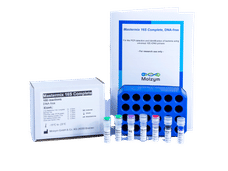Toxin detection as close as an inkjet printer
If that office inkjet printer has become just another fixture, it's time to take a fresh look at it. Similar technology may soon be used to develop paper-based biosensors that can detect certain harmful toxins that can cause food poisoning or be used as bioterrorism agents.
In a paper published in the July issue of Analytical Chemistry, John Brennan and his research team at McMaster University, working with the Sentinel Bioactive Paper Network, describe a method for printing a toxin-detecting biosensor on paper using a FujiFilm Dimatix Materials Printer.
The researchers demonstrated the concept on the detection of acetylcholinesterase (AChE) inhibitors such as paraoxon and aflatoxin B1 on paper using a "lateral flow" sensing approach similar to that used in a home pregnancy test strip.
The process involves formulating an ink like the one found in computer printer cartridges but with special additives to make the ink biocompatible. An ink comprised of biocompatible silica nanoparticles is first deposited on paper, followed by a second ink containing the enzyme, and the resulting bio-ink forms a thin film of enzyme that is entrapped in the silica on paper. When the enzyme is exposed to a toxin, reporter molecules in the ink change colour in a manner that is dependent on the concentration of the toxin in the sample.
This simple and cost-effective method of adhering biochemical reagents to paper is expected to bring the concept of bioactive paper a significant step closer to commercialization. The goal for bioactive paper is to provide a rapid, portable, disposable and inexpensive way of detecting harmful substances, including toxins, pathogens and viruses, without the need for sophisticated instrumentation. The research showed that the printed enzyme retains full activity for at least two months when stored properly, suggesting that such sensor strips should have a good shelf life.
Portable bio-sensing papers are expected to be extremely useful in monitoring environmental and food-based toxins, as well as in remote settings in less industrialized countries where simple bioassays are essential for the first stages of detecting disease.
Applications for bioactive paper also include clinical applications in neuroscience, drug assessment, and pharmaceutical development.
Most read news
Topics
Organizations
Other news from the department science
These products might interest you

Micro-Dx™ CE IVD by Molzym
Fully automated from sample to PCR analysis
Rapid identification of bacteria and fungi without time-consuming cultivation

DNA-free Taq Polymerases and Mastermixes by Molzym
DNA-free reagents for unrivalled sensitivity in molecular biology
Purity that makes the difference

DNA/RNA Shield™ SafeCollect Collection Kits by Zymo Research
Sample collection devices for simple & safe at-home testing
Best user experience for secure self-collection

Recombumin® Elite by Sartorius
ICHQ7 cGMP-compliant albumin for biotechnological applications
Increase consistency and safety for gene therapies and vaccines

CellGenix® Growth Factors and Cytokines by Sartorius
Recombinant growth factors without animal products
Optimised cell culture for T cells and MSCs in gene therapy

Greener Alternative Products by Merck
Sustainable laboratory products for environmentally conscious research
Over 2,500 ecological alternatives to reduce your laboratory footprint

Get the life science industry in your inbox
By submitting this form you agree that LUMITOS AG will send you the newsletter(s) selected above by email. Your data will not be passed on to third parties. Your data will be stored and processed in accordance with our data protection regulations. LUMITOS may contact you by email for the purpose of advertising or market and opinion surveys. You can revoke your consent at any time without giving reasons to LUMITOS AG, Ernst-Augustin-Str. 2, 12489 Berlin, Germany or by e-mail at revoke@lumitos.com with effect for the future. In addition, each email contains a link to unsubscribe from the corresponding newsletter.
Most read news
More news from our other portals
Last viewed contents
NIH_funding_of_IBS_Research
Researchers to Decode Antarctic Ice Metagenome with the 454 Sequencing System, to Explore the Effects of Climate Change
Study uncovers the structure of 1 adrenergic G-protein-coupled receptor (GPCR) - Structure of important drug target elucidated using Heptares' StaR(TM) technology
Ribosome
Blood_alcohol_content
UCB announces Phase 3 clinical trial program for epratuzumab in Systemic Lupus Erythematosus did not meet primary endpoint

Novel spatial-omics technology enables investigation of diseases at their early stages - How can you trace a single diseased cell in an intact brain or a human heart?
A long day for microbes, and the rise of oxygen on Earth





















































